| Patent Prosecution Highway |
Referenced Items (176, 177, 178, 179, 180, 181, 182, 183, 184, 185, 186, 187, 188, 189, 190, 191, 192, 193, 194, 195, 196, 197, 198, 199, 200, 201, 202, 203, 204, 205, 206, 207, 208, 209, 210, 211, 212, 213, 214, 215, 216, 217, 218, 219, 220, 221, 222, 223, 224, 225, 226, 227, 228, 229, 230, 231, 232, 233, 234, 235, 236, 237, 238, 239, 240, 241, 242, 243, 244, 245, 246, 247, 248, 249, 250, 251, 252, 253, 254, 255, 256, 257, 258, 259, 260, 261, 262, 263, 264, 265, 266, 267) |
(267) Notice Regarding Full Implementation of
Patent Prosecution Highway Program
between the United States Patent and
Trademark Office and the Japan Patent Office
I. Background
The United States Patent and Trademark Office (USPTO) has conducted a
Patent Prosecution Highway (PPH) pilot program with the Japan Patent Office
(JPO) for 18 months from July 3, 2006, to January 3, 2008. For a complete
description of the PPH pilot program, see "Patent Prosecution Highway Pilot
Program between the United States Patent and Trademark Office and the Japan
Patent Office," published on June 13, 2006 at 1307 OG 61, "Revised
Requirements for Requesting Participation in the Patent Prosecution Highway
Pilot Program in the USPTO," published on January 30, 2007 at 1314 OG 1398,
and "Revised Requirements for Requesting Participation in the Patent
Prosecution Highway Pilot Program in the USPTO," published on June 12, 2007
at 1319 OG 63. The results of the pilot program showed that (1) applicants
have been able to expeditiously obtain a patent in the Office of second
filing (OSF) at an early stage, by utilizing the petition to make special
procedures currently available in the OSF, based on claims that have been
allowed in the Office of first filing (OFF); (2) the OSF has been able to
reduce duplication of search efforts by exploiting the search and
examination results of the OFF to a maximum extent practicable; and (3) the
OSF has been able to reduce the examination workload since the scope of the
claims in the OSF application has been clarified through the OFF's
examination prosecution.
II. Full Implementation of the Patent Prosecution Highway Program
The USPTO and the JPO agreed at the November 2007 Trilateral Conference
to fully implement the PPH program on a permanent basis starting in January
4, 2008. The requirements for requesting participation in the PPH program
have been revised based on our experience with the PPH pilot program. In
particular, under the permanent program (1) the request for participation
in the PPH program and the supporting documents must be submitted via
EFS-Web; (2) applications eligible to participate in the PPH program have
been expanded to include PCT applications that contain no priority claims;
and (3) rather than having to submit a copy of all the Office actions from
the JPO application along with an English translation thereof, applicants
only need to submit a copy of the Office action from the JPO application
just prior to the "Decision to Grant a Patent" along with an English
translation thereof (e.g., the latest "Notification of Reasons for
Refusal").
Note that the procedures for a petition to make special under the
accelerated examination program set forth in MPEP 708.02(a) do NOT apply
to a petition to make special under the PPH program. The procedures and
requirements for filing a request in the USPTO for participation in the
PPH program are set forth below.
A. Requirements for Requesting Participation in the PPH Program in the
USPTO
In order to be eligible to participate in the PPH program, the
following conditions must be met:
(1) The U.S. application is
(a) a Paris Convention application which either
(i) validly claims priority under 35 U.S.C. 119(a) and 37 CFR 1.55
to one or more applications filed in the JPO, or
(ii) validly claims priority to a PCT application that contains no
priority claims,
or
 Top of Notices (267) December 31, 2013 Top of Notices (267) December 31, 2013 |
US PATENT AND TRADEMARK OFFICE |
1397 CNOG 870 |
(b) a national stage application under the PCT (an application which
entered the national stage in the U.S. from a PCT international
application after compliance with 35 U.S.C. 371), which PCT application
(i) validly claims priority to an application filed in the JPO, or
(ii) validly claims priority to a PCT application that contains no
priority claims, or
(iii) contains no priority claim,
or
(c) a so-called bypass application filed under 35 U.S.C. 111(a) which
validly claims benefit under 35 U.S.C. 120 to a PCT application, which
PCT application
(i) validly claims priority to an application filed in the JPO, or
(ii) validly claims priority to a PCT application that contains no
priority claims, or
(iii) contains no priority claim.
Examples of U.S. applications that fall under requirement (1) are:
(1)(a)(i):
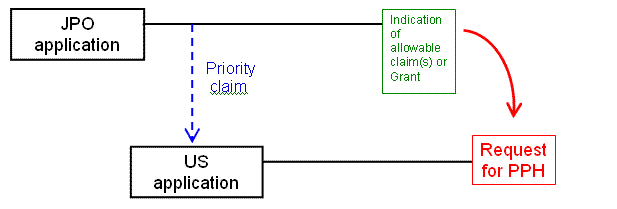
(1)(a)(ii):

* DO- Designated Office
(1)(b)(i):
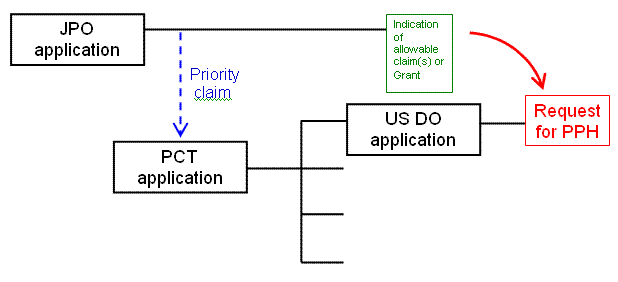
(1)(b)(ii):

(1)(b)(iii):

(1)(c)(i):
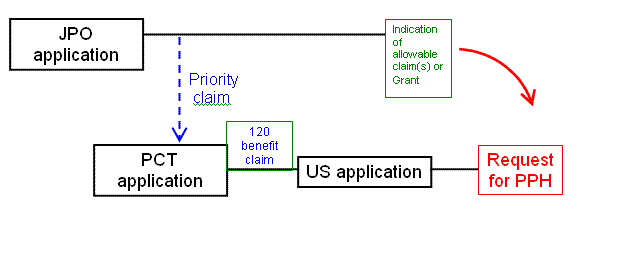
(1)(c)(ii):
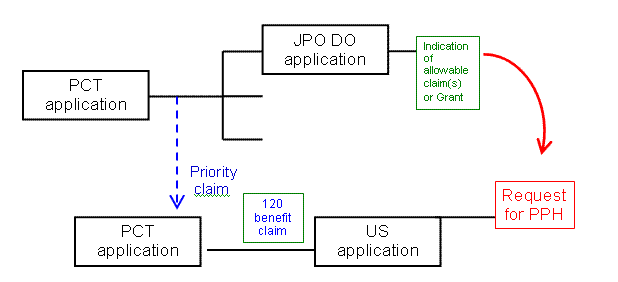
(1)(c)(iii):
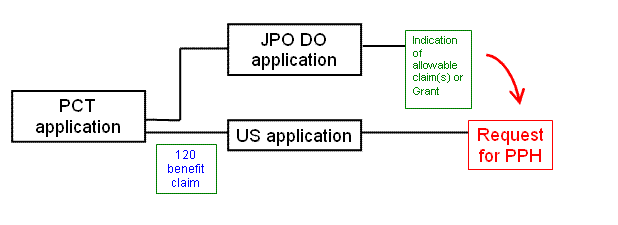
Note that where the JPO application that contains the
allowable/patentable claims is not the same application for which priority
is claimed in the U.S. application, applicant must identify the
relationship between the JPO application that contains the
allowable/patentable claims and the JPO priority application claimed in the
U.S. application (e.g., JPO application 2007-xxxxxx that contains the
allowable/patentable claims, claims internal priority to JPO application
2006-xxxxxx, which is the priority application claimed in the U.S.
application).
Provisional applications, plant and design applications, reissue
applications, reexamination proceedings, and applications subject to a
secrecy order are excluded.
(2) The JPO application(s) have at least one claim that was determined
by the JPO to be allowable/patentable. Applicant must submit a copy of
the allowable/patentable claims from the JPO application(s) along with an
English translation thereof and a statement that the English translation is
accurate. If a copy of the allowable/patentable claims from the JPO
application(s) is available via the Dossier Access System, applicant may
 Top of Notices (267) December 31, 2013 Top of Notices (267) December 31, 2013 |
US PATENT AND TRADEMARK OFFICE |
1397 CNOG 871 |
request that the USPTO obtain the copy via the Dossier Access System. In
this case, applicant is still required to submit the English translation
along with the statement that the translation is accurate. If the copies
cannot be obtained by the USPTO via the Dossier Access System due to
technical problems, applicant will be notified and requested to provide
the necessary documents.
(3) All the claims in each U.S. application for which a request for
participation in the PPH program is made must sufficiently correspond or be
amended to sufficiently correspond to the allowable/patentable claims in
the JPO application(s). Claims will be considered to sufficiently
correspond where, accounting for differences due to translations and claim
format requirements, the claims are of the same or similar scope. Applicant
is also required to submit a claims correspondence table in English. The
claims correspondence table must indicate how all the claims in the U.S.
application correspond to the allowable/patentable claims in the JPO
application(s).
(4) Examination of the U.S. application for which participation in the
PPH program is requested has not begun.
(5) Applicant must file a request for participation in the PPH program
and a petition to make the U.S. application special under the PPH program.
A sample request/petition form (PTO/SB/20JP) is available at the USPTO Web
site at http://www.uspto.gov/web/patents/pph/pph_jpo.html. Applicants are
encouraged to use the USPTO request/petition form. A petition fee under 37
CFR 1.17(h) for the petition to make special under 37 CFR 1.102(d) is
required and must be submitted.
(6) Applicant must submit a copy of the Office action from the JPO
application just prior to the "Decision to Grant a Patent" (e.g., the
latest "Notification of Reasons for Refusal") from each of the JPO
application(s) containing the allowable/patentable claims that are the
basis for the request, along with an English translation thereof and a
statement that the English translation is accurate. If the request for
participation in the PPH is based on an identification of
allowable/patentable claim(s) in a "Notification of Reasons for Refusal,"
then applicant must submit a copy of the "Notification of Reasons for
Refusal" along with an English translation thereof, and a statement that
the English translation is accurate.
It will not be necessary for applicant to submit a copy of the "Decision
to Grant a Patent" and an English translation thereof. If the JPO
application is a first action allowance, i.e., there is no Office action
just prior to the "Decision to Grant a Patent", then applicant should
indicate on the request/petition form that no Office action from the JPO
application is submitted since the JPO application was a first action
allowance. If a copy of the office action from the JPO application(s) is
available via the Dossier Access System, applicant may request that the
USPTO obtain the copy via the Dossier Access System. In this case,
applicant is still required to submit the English translation along with
the statement that the translation is accurate. If the copies cannot be
obtained by the USPTO via the Dossier Access System due to technical
problems, applicant will be notified and requested to provide the necessary
documents.
(7) Applicant must submit an information disclosure statement (IDS)
listing the documents cited by the JPO examiner in the JPO office action
(unless such an IDS has already been filed in the U.S. application).
Applicant must submit copies of all the documents cited in the JPO office
action (unless the copies have already been filed in the U.S. application)
except U.S. patents or U.S. patent application publications.
The request for participation in the PPH program and all the supporting
documents must be submitted to the USPTO via EFS-Web and indexed as
PPH.REQUEST. Information regarding EFS-Web is available at
 Top of Notices (267) December 31, 2013 Top of Notices (267) December 31, 2013 |
US PATENT AND TRADEMARK OFFICE |
1397 CNOG 872 |
http://www.ustpo.ogv/ebc/efs_help.html. Any preliminary amendments and IDS
submitted with the PPH documents must be separately indexed as a
preliminary amendment and IDS, respectively.
Where the request for participation in the PPH program and special
status are granted, applicant will be notified and the U.S. application
will be advanced out of turn for examination. In those instances where the
request for participation in the PPH program does not meet all the
requirements set forth above, applicant will be notified and the defects in
the request will be identified. Applicant will be given one opportunity to
perfect the request in a renewed request for participation (which must be
submitted via EFS-Web and indexed accordingly as noted above). Note that
action on the application by the examiner will NOT be suspended (37 CFR
1.103) awaiting a reply by the applicant to perfect the request in a
renewed request for participation. That is, if the application is picked
up for examination by the examiner after applicant has been notified of the
defects in the request, any renewed request will be dismissed. If the
renewed request is perfected and examination has not begun, the request and
special status will be granted, applicant will be notified and the U.S.
application will be advanced out of turn for examination. If not
perfected, applicant will be notified and the application will await action
in its regular turn.
(8) Request for participation in the PPH program and special status
granted in a parent application will not carry over to a continuing
application. Continuing applications must separately fulfill the
conditions set forth above.
If any of the documents identified in items (2), (6) and (7) above have
already been filed in the U.S. application prior to the request for
participation in the PPH pilot program, it will not be necessary for
applicant to resubmit these documents with the request for participation.
Applicant may simply refer to these documents and indicate in the request
for participation in the PPH program when these documents were previously
filed in the U.S. application.
C. Special Examining Procedures
Once the request for participation in the PPH program and special status
have been granted to the U.S. application, the U.S. application will be
taken up for examination by the U.S. examiner before all other categories
of applications except those clearly in condition for allowance, those with
set time limits, such as examiner's answers, and those that have been
granted special status for "accelerated examination."
Any claims amended or added after the grant of the request for
participation in the PPH program must sufficiently correspond to one or
more allowable/patentable claims in the JPO application(s). Applicant is
required to submit a claims correspondence table along with the amendment
(see B.(3) above). If the amended or newly added claims do not sufficiently
correspond to the allowable/patentable claims in the JPO application(s),
the amendment will not be entered and will be treated as a non-responsive
reply. Applicant must also submit copies of any office actions from each
of the JPO application(s) issued after the grant of the request for
participation in the PPH program (especially where the JPO might have
reversed a prior holding of allowability) along with English translations
thereof and a statement that the English translation is accurate.
The PPH program does not absolve applicants of all their duties under 37
CFR 1.56. By complying with requirements 6 and 7 identified above,
applicants would be considered to have complied with their duties to bring
to the attention of the USPTO any material prior art cited in the
corresponding foreign application(s) (see MPEP § 2001.06(a)). Applicants
must still provide to the USPTO other information known to them to be
material to patentability.
Any inquiries concerning this notice may be directed to Magdalen
Greenlief, Office of the Deputy Commissioner for Patent Examination Policy,
at 571-272-8800 or at magdalen.greenlief@uspto.gov.
December 28, 2007 JOHN J. DOLL
Commissioner for Patents
[1328 OG 44]







